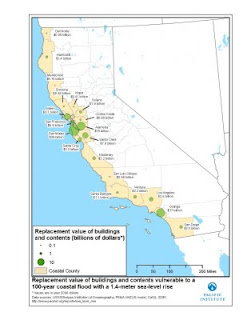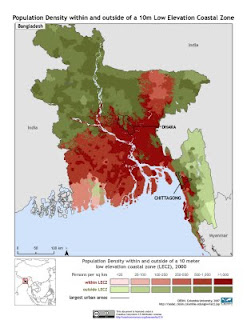-
Going Back to Cali–or Chennai: Cities Should Plan For “Climate Migration”
August 6, 2009 By Elizabeth Hipple On Monday, California became the first U.S. state to issue a report outlining strategies for adapting to climate change. Among other recommendations, it suggests that Californians should consider moving.
On Monday, California became the first U.S. state to issue a report outlining strategies for adapting to climate change. Among other recommendations, it suggests that Californians should consider moving.The report encourages California’s government agencies to consider “incentive programs to encourage property owners in high-risk areas to relocate,” and “avoid significant new development in areas prone to flooding, sea-level rise, temperature changes, and precipitation changes.” It points out that more than half ($2.5 trillion) of the total value of Californian real estate assets is at risk.
While California has been at the forefront of state governments in mitigation, the report notes that “adaptation is a relatively new concept in California climate policy.”
Other parts of the American West may also need to consider such adaptation strategies. Research recently released by scientists at the University of Colorado predicts that all of the reservoirs along the Colorado River could by dry by 2057 due to overuse and global warming. David Little, director of planning for Denver Water, told The Salt Lake Tribune that while he did not think that Denver’s water supplies would be affected, Denver could see an influx of people from California, Nevada, Arizona and New Mexico, who “are going to tend to migrate to places where they have water.”
Searching for Shelter in the Megacities of Africa, Asia
The consequences of climate change for the homes of people in the developing world are already much more dire than for Americans. A recent CARE International report, “In Search of Shelter: Mapping the Effects of Climate Change on Human Migration and Displacement” has brought attention to the 200 to 700 million people expected to be forced from their homes by 2050 due to climatic changes.
Urbanization has already led to the growth of “megacities” in the developing world with populations in the millions. If climate change forces millions of people to leave homes threatened by rising sea levels and desertification, “most migrants will move within their own country or region and, following an already well-trod pattern of rural-to-urban migration, many of them will head to cities,” writes the Climate Matters blog.
According to a study cited by the report, in West Africa between 1960 and 2000 “rainfall decreases, land degradation, and violence in the arid and semi-arid areas of Senegal, Mali, Burkina Faso and Niger resulted in a rapid intra-country migration southward and a swelling of big cities like Dakar, Bamako, Ouagadougou, Niamey and Kano.”
A Financial Times story about the town of Nandom, Ghana, illustrates some of these trends. A 2004 survey of the city’s residents revealed that all of the family members who left Nandom moved to the more prosperous southern region of Ghana and its cities, including the capital city of Accra In Africa in general, the UN City Initiatives estimates that “about one in three slum dwellers can be considered as an environmental refugee, driven off the land by advancing desert frontiers and failing farming systems.”
 While some will be fleeing the countryside for cities, others will be fleeing one city for another. According to data from CIESIN, more than 125 million people live within areas of India and Bangladesh that are vulnerable to a 10 meter rise in sea level. Sudhir Chella Rajan of the Indian Institute of Technology believes that residents of major Indian coastal cities such as Mumbai, Kolkota, and Chennai will be forced to move to large interior cities. “This would mean that already burdened cities such as Delhi, Bangalore, Ahmedabad, Pune, and Hyderabad, which will have serious resource constraints of their own by the middle of the century, will have to be prepared to accommodate enormous numbers of migrants from the coasts,” Rajan says in “Blue Alert: Climate Migrants in South Asia.“
While some will be fleeing the countryside for cities, others will be fleeing one city for another. According to data from CIESIN, more than 125 million people live within areas of India and Bangladesh that are vulnerable to a 10 meter rise in sea level. Sudhir Chella Rajan of the Indian Institute of Technology believes that residents of major Indian coastal cities such as Mumbai, Kolkota, and Chennai will be forced to move to large interior cities. “This would mean that already burdened cities such as Delhi, Bangalore, Ahmedabad, Pune, and Hyderabad, which will have serious resource constraints of their own by the middle of the century, will have to be prepared to accommodate enormous numbers of migrants from the coasts,” Rajan says in “Blue Alert: Climate Migrants in South Asia.“If such predictions are true, and millions of people will be moving to and from cities ill-equipped to handle the disruption, more cities and states need to develop adaptation plans like California’s. They certainly wouldn’t want to emulate the bad example set during the Great Depression, when an LAPD “bum blockade” turned away farmers fleeing the Dust Bowl. (Instructively, geographer Robert McLeman tells Slate that the most mobile “climate migrants” during this era were members of the working middle class, not the rich or the poor).
While mitigating climate change is and should continue to be a critical part of all plans to address the issue, cities in particular must begin to plan how they are going to absorb the influx of new residents as climate change hastens urbanization.
Elizabeth Hipple is an intern with the Comparative Urban Studies Project.
 A Publication of the Stimson Center.
A Publication of the Stimson Center.

 On Monday, California became the first U.S. state to issue a
On Monday, California became the first U.S. state to issue a  While some will be fleeing the countryside for cities, others will be fleeing one city for another. According to
While some will be fleeing the countryside for cities, others will be fleeing one city for another. According to 

